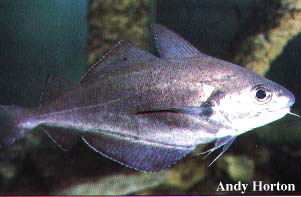Identification:
A deep bodied codfish with slightly compressed sides, with three dorsal and
2 anal fins. The anterior dorsal fin is high and pointed due to the elongation
of it's first ray, and subsequent diminishment of the rays behind it, coupled
with it's narrow base. In contrast the anterior anal fin has a wide base,
starting beneath the centre of the first dorsal, and ending behind the junction
of the second and third dorsal fins. The lateral line is distinct and continues
to the tail fin. The head accounts for about a fifth of the total length.
The eyes are large in comparison to the head size. The top jaw is longer
than the lower jaw. A well developed barbel is present on the chin, and is
almost the same size as the diameter of the eye. The mouth angle is below
the eye.
The back is a copper brown, that fades to an iridescent brownish yellow,
with an almost pinkish sheen, on the sides, and a white belly. The sides
often exhibit four or five dusky vertical bars or bands, with a characteristic
black spot at the base of the pectoral fins.
Breeding:
Spawns around March to April in waters with temperatures of at
least 8 to 9oC, and hatch in 10 to 12 days.Reach maturity
at the end of their first year with a body length of around 24cm or so. Reach
about 30cm in length in their third year.
Habitat:
Common inshore fish of waters with depth from 3 to 100m, although 300m is
not unknown. Small pout are to be found in shallow water over sandy ground,
whilst the larger adults tend to favour rocky substrates and wrecks. Loose
shoaling fish, that tends to be demersal in nature.
Food:
Diet consists mainly of amphipods, shrimps, crabs, and other crustaceans,
and maybe supplemented with squid, small fish, and polychaete worms.
Range:
Occurs throughout the waters of the UK, especially
in the NorthSea, English Channel, and Western
Coasts.
Additional Notes:
Poor Eating. |
